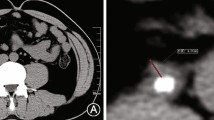Abstract
Purpose
To identify risk factors by developing and internally validating a nomogram for preventing perioperative complications in overnight ureteral catheterization cases after fURS for kidney stones.
Methods
We retrospectively examined 309 patients with overnight ureteral catheterization after single fURS procedures for renal stones. fURS procedures were performed based on the fragmentation technique. The ureteral catheter was removed on postoperative day 1. Within this group, patients who experienced perioperative complications (complication group) were compared with those who did not experience complications (non-complication group). The complication group included 77 patients whose Clavien–Dindo classification score was I, II, III, or IV and/or those whose body temperature during hospitalization was over 37.5 °C.
Results
The overall stone volume, stone-free rate, incidence of perioperative complications, and procedure duration were 1.39 mL, 94.8%, 24.9%, and 62 min, respectively. Severe complications of a Clavien–Dindo level III or IV were observed in only four cases (1.3%). Multivariate assessment revealed five independent predictors of perioperative complications after fURS with overnight catheterization: age (p = 0.11), sex (p = 0.067), stone volume (p = 0.33), Hounsfield units (p = 0.16), and narrow ureter (p = 0.018). We developed a nomogram to predict perioperative complications after fURS using these parameters.
Conclusions
We developed a predictive model for perioperative complications of patients with overnight catheterization after fURS for renal stones. This model could select patients who were at a low risk of complications.

Similar content being viewed by others
Abbreviations
- AUROC:
-
Area under the receiver-operating characteristic curve
- fURS:
-
Flexible ureteroscopy
- NCCT:
-
Non-contrast computed tomography
- POD:
-
Postoperative day
- SF:
-
Stone-free
References
Breda A, Ogunyemi O, Leppert JT, Schulam PG (2009) Flexible ureteroscopy and laser lithotripsy for multiple unilateral intrarenal stones. Eur Urol 55:1190–1196. https://doi.org/10.1016/j.eururo.2008.06.019
El-Nahas AR, Ibrahim HM, Youssef RF, Sheir KZ (2012) Flexible ureterorenoscopy versus extracorporeal shock wave lithotripsy for treatment of lower pole stones of 10–20 mm. BJU Int 110:898–902. https://doi.org/10.1111/j.1464-410X.2012.10961.x
Cohen J, Cohen S, Grasso M (2013) Ureteropyeloscopic treatment of large, complex intrarenal and proximal ureteral calculi. BJU Int 111:E127–131. https://doi.org/10.1111/j.1464-410X.2012.11352.x
Breda A, Ogunyemi O, Leppert JT, Lam JS, Schulam PG (2008) Flexible ureteroscopy and laser lithotripsy for single intrarenal stones 2 cm or greater–is this the new frontier? J Urol 179:981–984. https://doi.org/10.1016/j.juro.2007.10.083
Pearle MS, Lingeman JE, Leveillee R et al (2008) Prospective randomized trial comparing shock wave lithotripsy and ureteroscopy for lower pole caliceal calculi 1 cm or less. J Urol 179:S69–73. https://doi.org/10.1016/j.juro.2008.03.140
Raheem OA, Khandwala YS, Sur RL, Ghani KR, Denstedt JD (2017) Burden of urolithiasis: trends in prevalence, treatments, and costs. Eur Urol Focus 3:18–26. https://doi.org/10.1016/j.euf.2017.04.001
Giusti G, Proietti S, Villa L et al (2016) Current standard technique for modern flexible ureteroscopy: tips and tricks. Eur Urol 70:188–194. https://doi.org/10.1016/j.eururo.2016.03.035
Haleblian G, Kijvikai K, De La Rosette J, Preminger G (2008) Ureteral stenting and urinary stone management: a systematic review. J Urol 179:424–430. https://doi.org/10.1016/j.juro.2007.09.026
Nabi G, Cook J, N’Dow J, McClinton S (2007) Outcomes of stenting after uncomplicated ureteroscopy: systematic review and meta-analysis. BMJ 334:572. https://doi.org/10.1136/bmj.39119.595081.55
Komeya M, Usui K, Asai T, Ogawa T, Taguri M, Kataoka K, Yao M, Matsuzaki J (2018) Outcome of flexible ureteroscopy for renal stone with overnight ureteral catheterization: a propensity score-matching analysis. World J Urol 36:1871–1876. https://doi.org/10.1007/s00345-018-2328-1
Ito H, Kawahara T, Terao H, Ogawa T, Yao M, Kubota Y, Matsuzaki J (2012) The most reliable preoperative assessment of renal stone burden as a predictor of stone-free status after flexible ureteroscopy with holmium laser lithotripsy: a single-center experience. Urology 80:524–528. https://doi.org/10.1016/j.urology.2012.04.001
Ahn ST, Kim JH, Park JY, du Moon G, Bae JH (2012) Acute postoperative pain after ureteroscopic removal of stone: incidence and risk factors. Korean J Urol 53:34–39. https://doi.org/10.4111/kju.2012.53.1.34
Darrad MP, Yallappa S, Metcalfe J, Subramonian K (2018) The natural history of asymptomatic calyceal stones. BJU Int 122:263–269. https://doi.org/10.1111/bju.14354
Kanda Y (2013) Investigation of the freely available easy-to-use software ‘EZR’ for medical statistics. Bone Marrow Transplant 48:452–458. https://doi.org/10.1038/bmt.2012.244
Song T, Liao B, Zheng S, Wei Q (2012) Meta-analysis of postoperatively stenting or not in patients underwent ureteroscopic lithotripsy. Urol Res 40:67. https://doi.org/10.1007/s00240-011-0385-7
Funding
This study was funded by a Grant-in-Aid for Scientific Research (C) 19K09718 (to M.J. and K.M.)
Author information
Authors and Affiliations
Contributions
MK: project development, data collection, and manuscript writing. KO: data collection. JA: data collection. TA: data collection. YS: data analysis. TO: project development and manuscript editing. MY: project development. JM: project development.
Corresponding author
Ethics declarations
Conflict of interest
The authors declare that they have no conflict of interest.
Research involving human participants and/or animals
This study was approved by the Institutional Ethics Committee of Ohguchi East General Hospital.
Informed consent
Informed consent was obtained from all individual participants included in the study.
Additional information
Publisher's Note
Springer Nature remains neutral with regard to jurisdictional claims in published maps and institutional affiliations.
Rights and permissions
About this article
Cite this article
Komeya, M., Odaka, H., Asano, J. et al. Development and internal validation of a nomogram to predict perioperative complications after flexible ureteroscopy for renal stones in overnight ureteral catheterization cases. World J Urol 38, 2307–2312 (2020). https://doi.org/10.1007/s00345-019-03023-y
Received:
Accepted:
Published:
Issue Date:
DOI: https://doi.org/10.1007/s00345-019-03023-y




